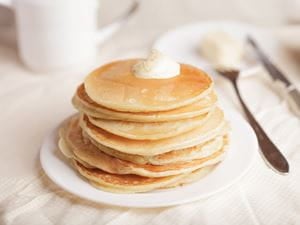
Shrove Tuesday is a traditional Christian feast day that falls before the beginning of Lent on Ash Wednesday. Lent, the 40 days preceding Easter was traditionally a time of fasting, and on Shrove Tuesday, Christians attended confession and were “shriven,” or absolved of sin. Shrove Tuesday is a holiday with no set date, always falling 47 days before Easter Sunday.
It’s also the day when many pig out on pancakes.
So what’s the connection between faith and flapjacks? To find out, let’s take a look at what happens during the 40 days of Lent.
Lent commemorates the forty days Christ spent fasting in the desert, and during this solemn period of observance, Christians commit to fasting, and to giving up certain luxuries in order to remind themselves of the value of repentance. Many believers also undertake a daily devotional during these weeks in order to draw closer to God and to focus on the death and resurrection of Christ.
As celebrated by Christians in the past, Shrove Tuesday, with its place just before the beginning of a long fast, was the final opportunity to use up perishable items, such as fats, butter and eggs, before beginning the Lenten fast.
And what the perfect way to combine these endangered ingredients, you might ask? Pancakes, of course!
These familiar flat cakes, cooked up from batter in a frying pan, have a long and storied history that dates back to the 15th century. In the case of Shrove Tuesday, their ingredients symbolize ideas significant to the Lenten season. The eggs symbolize creation, the flour represents the mainstay of the human diet, the salt conjures ideas of wholesomeness, and the milk stands in for purity.
The egg is an especially potent symbol. Christians in the Eastern Catholic and Orthodox churches once celebrated Easter with eggs dyed red, symbolizing the blood of Christ that was shed on the cross. The shell of the egg represented the tomb, and the chick’s escape from the shell is symbolic of Christ’s resurrection and escape from the tomb.
So that food would not be wasted, many families would hold a feast on “shriving Tuesday,” and consume all the foods that wouldn’t last through the forty days of Lent. Interestingly, it was this feast from which the festival of Mardi Gras originates—a tradition of a very different sort. Mardi Gras is French for “fat Tuesday,” in reference to the consumption of perishable fats on Shrive Tuesday before the fasting of the Lenten season. The most recognizable Mardi Gras celebration is, perhaps, that in New Orleans, where parades, costumes, masks, and music reign.
Regardless of its roots, many of the religious traditions of this holiday have fallen aside, leaving Shrove Tuesday to be better known simply as “Pancake Day,” which is celebrated in various ways the world over.
In what is perhaps the best-known Shrove Tuesday celebration, the Pancake Day Race at Olney in Buckinghamshire, England, has been held since 1445. The race finds its mythic origin in the story of a woman who was making pancakes when she heard the shriving bell ring out across the town, summoning her to confession. Since church attendance was compulsory at the time, she ran to church in her apron, frying pan in hand, complete with a still-cooking pancake. Thus, the 500 the race’s 500 year tradition began.
Today, the Pancake Day Race is run by the apron-clad housewives of Olney, each of them holding a frying pan containing a hot pancake. The winner must toss this pancake three times during the race, and be the first to arrive at the church, serve her pancake to the ringer of the shriving bell, and receive a kiss from him.
In Liberal, Kansas, the same tradition began in February of 1950, when members of the Liberal Junior Chamber of Commerce learned about the Olney race and proposed a competition with the English community, making the Pancake Day Race truly international.
Across the rest of the world, Shrove Tuesday is celebrated in myriad ways, through a variety of deliciously different pancakes. Let’s take a look at a few of the best!
The Frenc, gravitate toward crepes, the thinnest variety of pancake that are often filled with anything from sugar to jam to meats and cheeses.
In Australia, the pancake of the day is the pikelet, which is a small buttermilk pancake served with afternoon tea, often topped with butter or jam.
Austrians serve kaiserschmarrn, which is comprised of pieces of broken-up, caramelized pancake that is topped with fruit and nuts.
The pancake of Thailand is the roti, which is a sweet, rolled pancake coated in sweetened condensed milk and sometimes topped with caramelized bananas.
Russians eat buckwheat blini, which is usually served as a religious rite, and is served with butter, sour cream, or caviar.
And, of course, most of us are familiar with good old fluffy American pancakes, served straight from the griddle and drizzled with plenty of maple syrup.
Whatever type of pancake you love best, remember to indulge on Pancake Day. And no matter what your faith, and no matter if you know this holiday as Pancake Day, Mardi Gras, Carnival, or Shrove Tuesday, it’s useful to celebrate this day in its original spirit. Consider the actions you’ve taken in the past year, and dwell upon the ramifications of those actions. If there’s anything you’d like to change, now’s the time.
Although if your resolution is to eat fewer pancakes, well—that can wait one more day.

